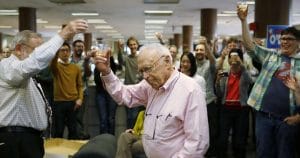After graduating with a masters degree in journalism from Columbia in 1940, Perlman quickly got a job at the San Francisco Chronicle. “Being a reporter is one of the best jobs in the world,” he said, but his career was interrupted by World War II. He worked for the Army’s media branch, and when released went to work for the New York Herald Tribune. But the city by the bay continued to tug at him, and he returned to the Chron in 1951. He always worked as a general assignment reporter (pretty much, “anything” was his beat), but then he broke his leg. While recovering in 1957, a friend gave him the book The Nature of the Universe. “I started reading it and thought, ‘Well, this is fascinating,’ so when I got back to work I started looking around for science stories,” he said years later. “Pretty soon I was hooked. I was a science writer from then on.”

Except for when he reluctantly took the job of City Editor at the Chron, and was tasked with directing coverage of the suicide of more than 900 members of the “Peoples Temple” (which was headquartered in San Francisco) and, just 11 days later, the murder of San Francisco Mayor George Moscone and Supervisor Harvey Milk (which was chronicled in the 2008 film, Milk). While he disliked being in management, he was gleeful he had the power to hire people. Anytime there was an opening, he’d hire a woman — because, he said, the paper didn’t have enough of them on staff. But he really wanted to go back to being a reporter, and upper management finally let him. He continued as a science reporter for the rest of his career. “Every story you write, you ought to learn something,” he said about why he kept working long past what most consider to be retirement age. “I have stayed in the business because every story I’ve written has answered some questions. I keep learning.” As news organizations cut budgets for science coverage, Perlman warned that would create “a generation with a major disability in what they can think about and understand.”
Perlman didn’t think much of awards, but he got them anyway: from the American Association for the Advancement of Science, the Society of Professional Journalists, the American Chemical Society, the American Geophysical Union, the United States Geological Survey. In 2000, the American Geological Union recognized his contributions to science news reporting by instituting the David Perlman Award for Excellence in Science Journalism. He served as the president of the National Association of Science Writers, and the Council for the Advancement of Science Writing. He was a Fellow of the California Academy of Sciences, and was the first journalist to receive the University of California San Francisco’s UCSF Medal, its highest honor. By the time Perlman retired in 2017 after more than 60 years at the Chronicle, he was the oldest full-time news reporter at an American metropolitan newspaper — 98. The whole time, he typed — fast — with two fingers. He died from cancer at his home in San Francisco on June 19, at 101.
